Yet another post that seems to be a purposeful assault on every loyal reader that enjoys my wacky attempts at new eggplant and bread recipes. This one is about an item that I can only assume usually ends up in dog food.
This post is a few months in the making at this point. I feel like I’ve been threatening to write about udder for some time but hadn’t finished everything required to create a (somewhat) well informed post. So, now here we are, with a whole post about cooking something you can pretty much only obtain in the U.S. if you know someone slaughtering a cow. However, it’s apparently a common item in a few South American countries at restaurants that grill all parts of the cow, which means I had to try it.
A little refresher on what came in Uncle Billy’s Crazy Cooler of Destiny (working title):
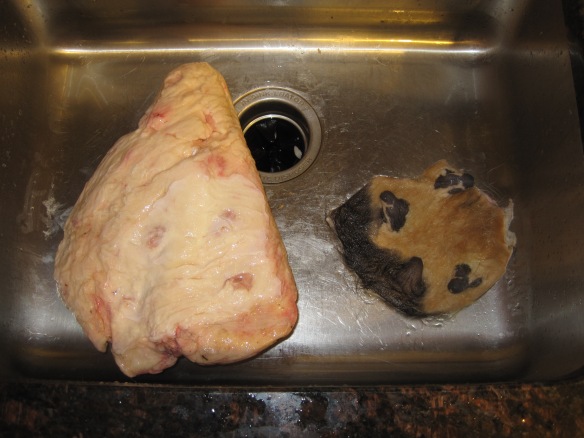
Seeing this photo reminds me of how bummed out I was when I saw the fur and hair still attached to the outside of the udder. Like that massive-sized chunk of almost pure fat wasn’t enough to make my knees buckle
This 15 pound chunk of udder was divided up into 4 portions and frozen separately so I could slowly make use of all of it. Lucky me.
The first attempt was relatively straightforward and coincided with the cooking of the Ponce back in May. It started with trimming the outside edges off of the block to get rid of the random ugly-looking bits I missed originally.
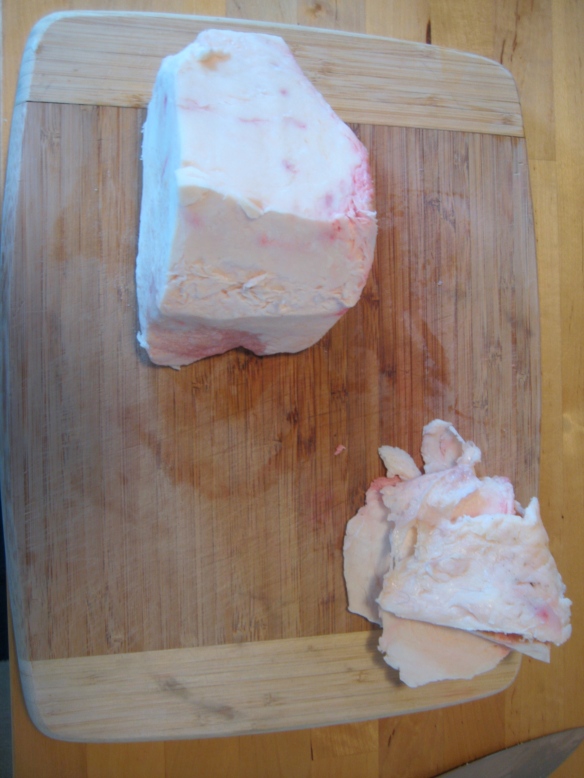
“Oh here, let me make this foul looking piece of sort-of food less gross by trimming off some gross stuff that people would have never noticed because they won’t eat it.” – Me, always
I was working a little haphazardly with the udder on this round since I was completely over-invested in the fate of the ponce. Not sure it would have mattered, though, since there aren’t many resources on how to cook cow’s udder online and I was pretty much flying blind the whole time. So, I simply sliced the udder into quarter inch thick slabs and soaked in salted water for a few hours.
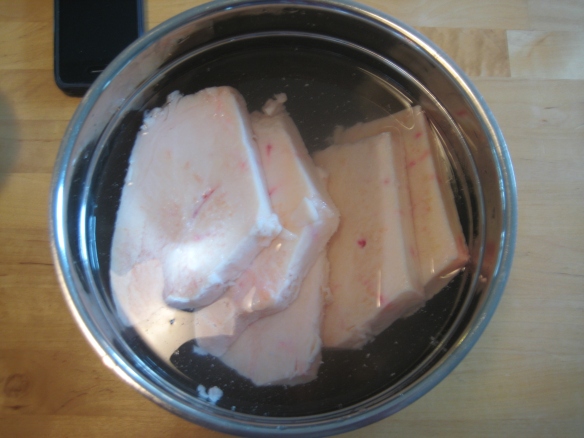
Nobody should ever eat anything that looks like a deck of cards made out of fat. But, if that’s the hand you draw, I guess you gotta go with it. Puns! They’ve worked previously!
While the ponce finished cooking in the oven, we fired up the grill to cook kielbasa so I seasoned the udder with salt and pepper and threw the slabs onto the grill.
After a good ten minutes on each side, the udder came off and headed to a cutting board to be sliced up for the hungry masses (me).
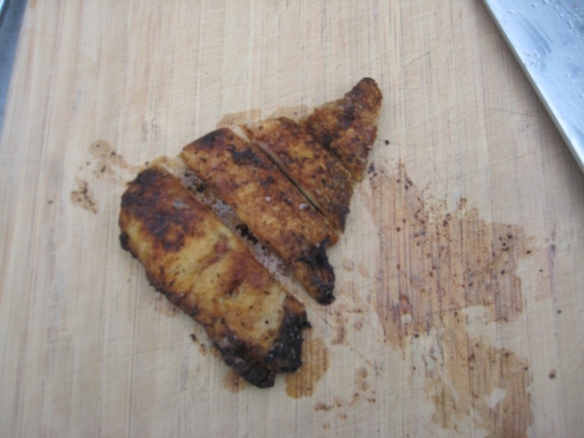
Looked kinda like a chicken cutlet but smelled like the fat on the edge of grilled steak. Even looking at it now it’s hard to believe that is a piece of cow udder. Cow udder!
I wasn’t entirely sure what to expect, but it was still not quite what I expected. First, it tasted like the fat on a good piece of grilled steak; definitely beef-like and fatty in flavor, but almost like I’d covered it with unsalted butter before cooking. I had assumed the texture would be a melty, soft, fatty texture but I was pretty off-base on that one. The outside was chewy, like severely overcooked calamari chewy, and borderline crunchy with a soft inside. Not something you could eat a lot of, but kind of addictive due to the texture and flavor. I ate more pieces than I should have.
With that experience fresh in my mind, I recognized I still had a lot of udder left in the freezer and wanted to try a new technique the second time around. During our trip to Italy a couple years ago, I fell in love with the insanely unhealthy and delicious cured lardo at Giostra in Florence. Usually made with pork fatback, I had never seen a beef equivalent; like a beef bressaola to pork’s prosciutto. The internets had no info on a beef lardo equivalent or even how to cure beef fat, so of course I was intrigued. It all started with a block of udder cut into two equal width halves.
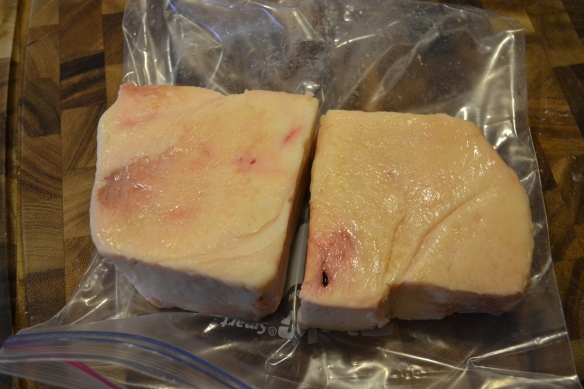
This one looked a little different than the last block, possibly due to an extra post-thaw day in the fridge that was a bit of a questionable decision. Like this whole effing blog entry wasn’t an incredibly questionable decision
With curing something this large, unlike the relatively simple duck prosciutto, there are more concerns about creepy bacteria and, particularly, botulism. Pink salt, a nice term for salt mixed with sodium nitrite and a little nitrate, has to be used in order to ensure that the end product is safe to eat. Nitrites/nitrates are pretty villainized but a reality of most charcuterie. I mixed a cup of salt with a couple tablespoons of pink salt, garlic powder, dried thyme, dried sage, and lots of black pepper.
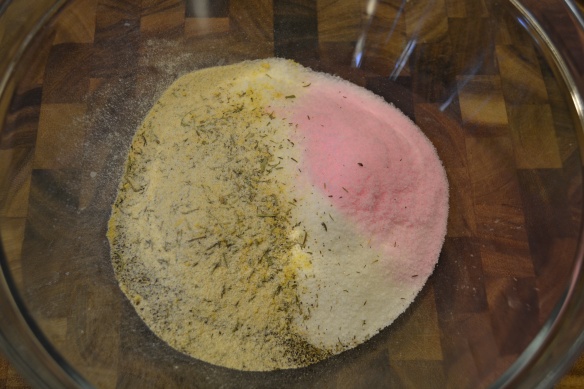
I let Janet consume reasonable amounts of dirt and grass (you really can’t help it) and don’t mind her crawling around in public places, but I was acting like an insane parent with how I handled the pink stuff. That stuff is no good for babies, probably bad for adults too but at least we get to enjoy its delicious riches
I lined the bottom of a glass pyrex with the salt mixture, then placed the udder pieces into the dish and covered all sides completely with the salt making sure no parts of the meat were left exposed.
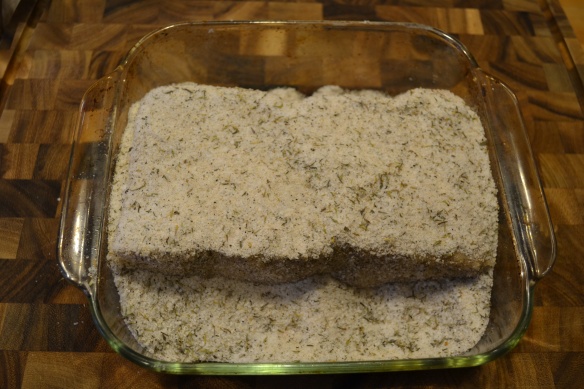
It was a snug fit but better than being in a much larger dish and needing more salt. The coating also did a solid job of hiding the oddness underneath it. Salt, is there anything you can’t do?
I wrapped the dish tightly in two or three layers of plastic wrap and then placed my special cooking brick (we found it in the garden and wrapped it in tin foil) on top of the udder. The idea is that while it cures in the salt, the weight would press out excess bacteria-risky liquid. The whole kit and kaboodle (how have I not used that expression here before) went into the fridge for 30ish days.
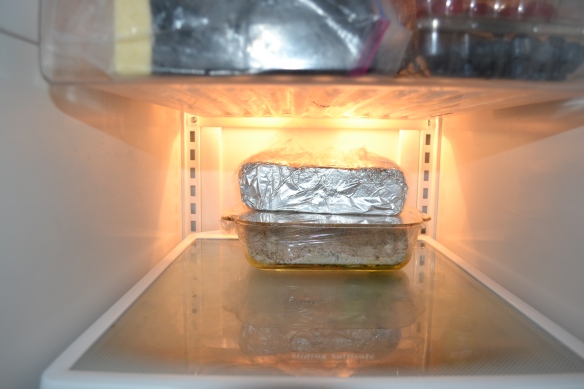
The fridge light makes this look both creepy and sh*tty-filter-that-everyone-uses-on-Instagram-y. I would describe myself as generally irritated by Instagram. I would also describe myself as generally irritated about everything
Over the next 30 days, I pulled the dish out every five days or so to flip the udder pieces, pack in the same salt mixture, re-cover, and weight. Over time, the salt got progressively wetter and there was liquid collecting in the dish. I wasn’t sticking to any specific timetable, I was winging this one and lardo usually comes out after seven days, but eventually I decided it was time to remove it from the salt.
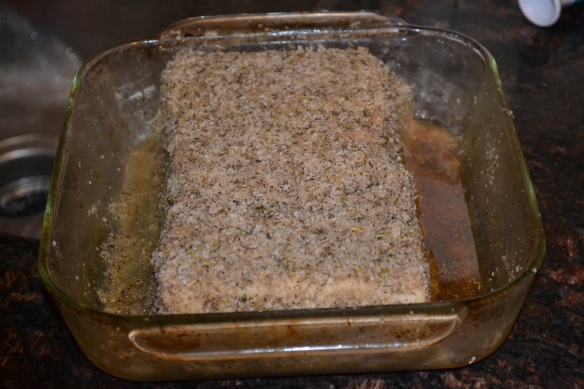
That was some viscous liquid collecting around the sides, but it was nice to see that something had changed and looked different. I was putting way too much effort into this thing to have no progress
Each piece was removed from the mud-like salt and given a quick rinse in water and then white wine. The white wine was a bit odd in retrospect, but lardo and proscutto recipes call for a fortified wine rinse, and I didn’t care to figure out what “fortified wine” meant, so I broke out the ollllld Chuck Shaw.
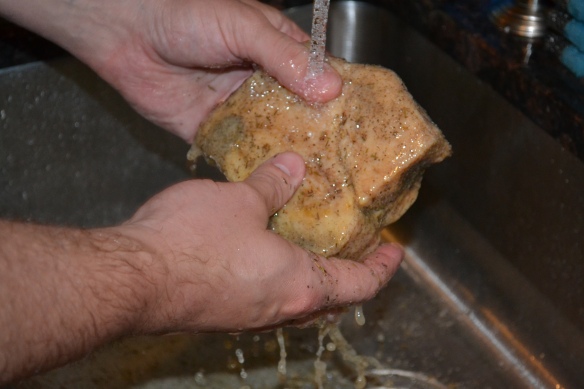
You know we’ve switched to the good camera when the water looks like this. We’ve also reached the portion of the program when Kristi agreed to participate. Also, the dark spots are pieces of dried herb that stuck around throughout the process
With the bottom half of the wine fridge lined in light-blocking cardboard from the inside (as discussed in previous posts) I had a 54 degree location that was perfect for curing. I poked a hole in each slab with a bamboo skewer, pressed a string through it, then tied it to the bottom side of one of the wine racks to hang.

Ended up having to redo this so that they were both on the same string and wouldn’t swing into each other. In hindsight it was a pretty stupid concern, it’s not like the fridge was going to be in the hold of ship
And that was pretty much the last I saw of the udder for the next 60-ish days. The rack slid back into the wine fridge and the udder cured in 54 degree temperatures in what I came to know as “the curing box”. Kristi still calls it the wine fridge.
After a couple months of curing and some general food boredom post-St. Anthony’s feast in the north end of Boston, I pulled the udder out of the wine fridge.
After a few minutes of staring, smelling, poking and general stalling, I finally started cutting off some slices from the block.
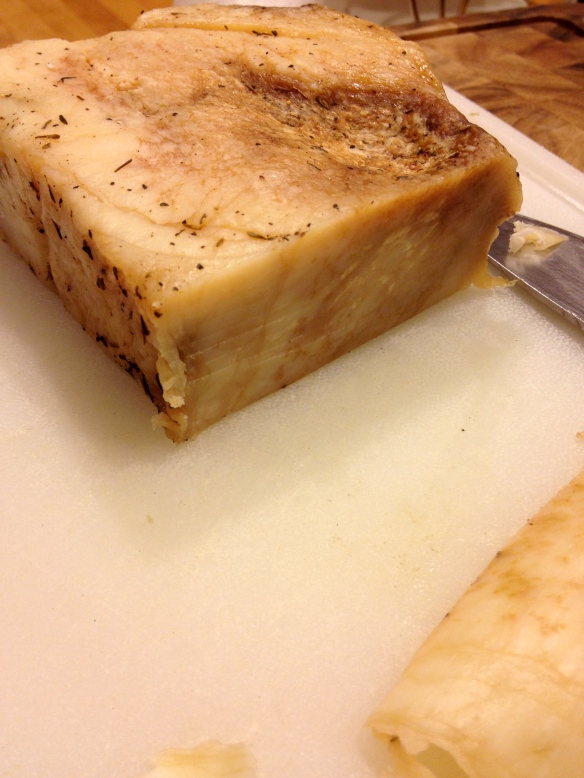
Just a big old block of cured beef fat. The discovery of foods like this is rarely done by people of smaller dimensions than mine. Let’s just say I don’t think this is the type of food Giada De Laurentiis is making at home. Before looking her up just now I was unaware she spelled her last name with two “i”s and now I am pretty sure that’s not her real name. Another thing I am generally annoyed by
The key with any lardo is to slice very, almost transparently, thin. After tasting a tiny piece raw, I decided this was definitely the type of food that would taste better with some heat applied to it. Toasting pieces of baguette and letting the lardo melt onto them seemed like the best course, but I didn’t have any good bread in the house so I fried up a batch like bacon.
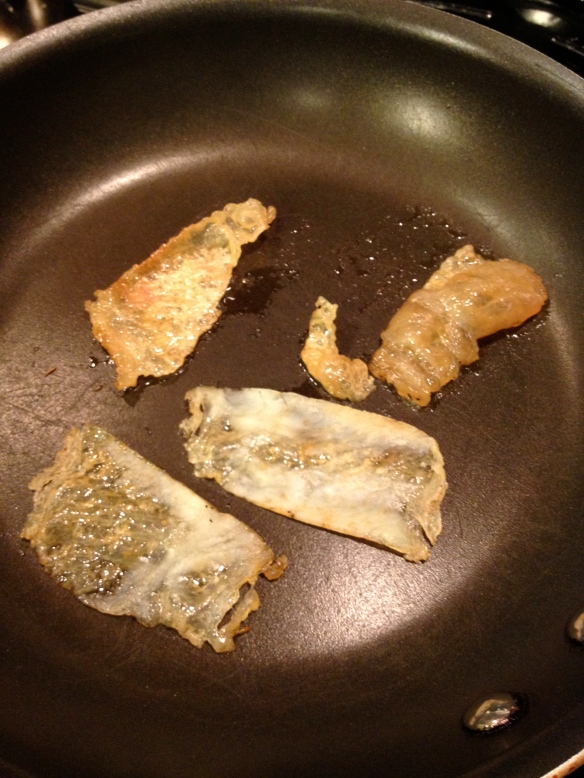
Thought I had a good shot of the thin slices on the cutting board but apparently not. Has the transition back and forth from the good camera to the iPhone been jarring? I find it jarring
While the slices cooked the smell was somewhere between pan cooked steak and a natural tallow candle. It definitely was a reminder that what I was about to eat ends up as something other than people food 99.9999% of the time in America. Not that I think that’s wrong; udder isn’t exactly the next head cheese coming to the menus of trendy gastro-pubs nationwide.
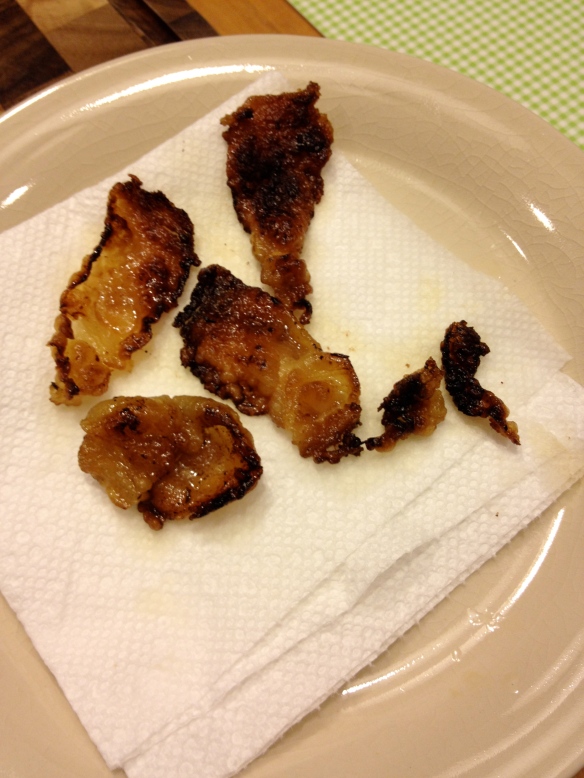
It looked/smelled reasonably appetizing at this point. Not sure you can go wrong frying something fatty and cured like you would bacon, seems to always work. Again, not the type of conversation you’re going to hear around the starting line at a 10k
Cured cow udder isn’t for everyone, but it was actually kind of good. The most shocking thing is how sweet the cured udder is. Not like how I would describe shellfish as sweet, this was very sugar-like. It legitimately tastes like bacon that has been baked with brown sugar on it, almost a candied flavor. I racked my brain to try to remember if I had put sugar in the cure but realized the sweetness was coming from the udder. Likely the last remnants of the milk which is gross or cool depending on how you look at it.
Obviously I was working with just the fat here, so there wasn’t a lot of texture aside from the crispiness, but it really tasted like beef-flavored crispy bacon fat. I am actually looking forward to frying this up again and seeing what I could pair it with. Will likely experiment with it some more in LBI this weekend.
I am just happy it was edible, I really thought I would be throwing it out after 90 days of (minimal) effort. Hopefully I’ll do a post everyone can enjoy next week.

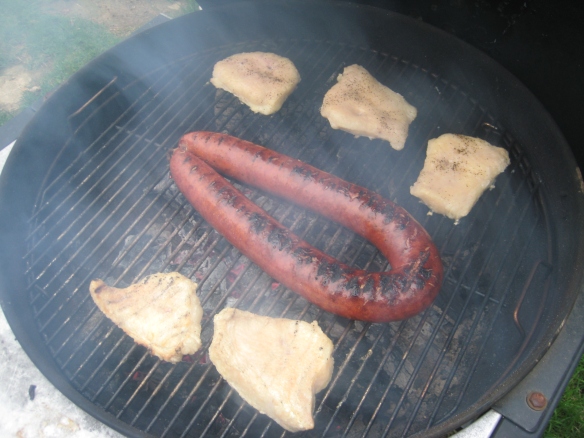
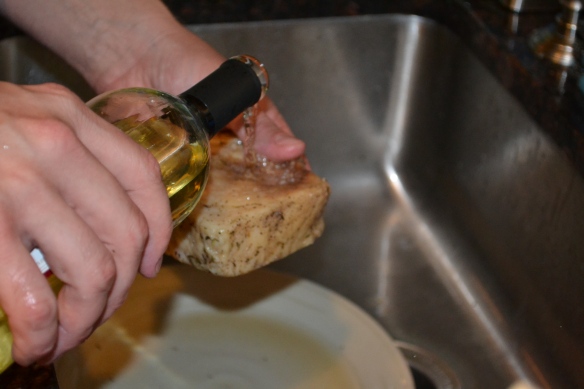
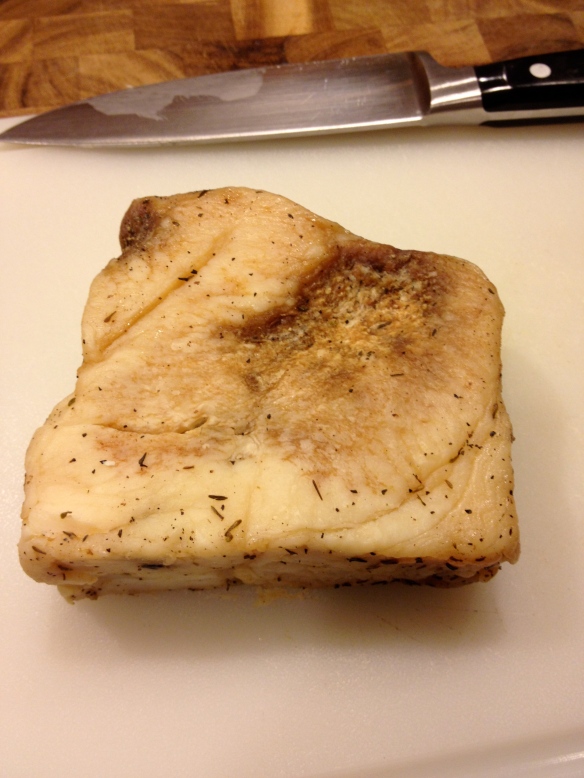
Dang dude.
Interesting. Grow Dee!
That was interesting, thank’s for sharing.
You should try the Pakistani equivalent of cows udder. It is called “kheeri” around these parts. Cut it up into bite size cubes. Depending on your tolerance of spices, marinade in half to one teaspoon red chilli powder, half teaspoon turmeric powder, the juice of 1 lemon, a pinch of garam masala and salt to taste ( for about 500 gms of udder) All spices are available at indian stores, or you could just use prepackaged tikka masala, though it is difficult to control the intensity of the spices. Marinade overnight, then skewer and barbeque until cooked through. Enjoy!👍
Please, please, please, tell me where can I buy udder. Fresh or frozen. Please.
I’ve found some recipes that require a cooking time of 5-6 hours in broth, leaving it to cool in the broth and then slicing it up and eating it like that or let it touch the heat for a couple of minutes in a little bit of butter.
Udder is not ready unless you boil it for at least 4 hours. Then you can use different cooking techniques. Don’t throw it out, better give to cats or dogs.
You kind of stole my blog#4, but I liked yours more. I hear they smoke cure udder in the Swiss Alps, so there you go
Really a very cool entry! I come from the country and respect any attempt to reduce waste of our animals used for food. Great work!
Im my country we eat salted udder in soups! its delicious!!!
if you need the recipe, write me! congratulations!!!
My orthodox Jewish family, in the 1940’s used to make a delectable stew of cubed cow udder with onions and potato. The udder was first charred in a coal furnace (to make it Kosher … to “burn out” any remaining traces of milk … (cannot mix meat and milk in a Kosher kitchen). The charred bits were trimmed off, and the udder was eventually cubed and stewed with onions and potatoes. I have been trying to find the recipe, and have had no luck. The flavor of the stew was magnificent. I will never forget it. It makes my mouth water to think of it. I do not know how the stew was made. The cubes of udder had a texture and flavor unmatched in my life-long experience. I wish I could prepare it now. I would love to taste it once again.
where to buy udder in the USA _? let me know e’mail : isachiri6464@hotmail.com
As far as i,m Aware Cow,s Udder or Elder as not Been Avliable Like Lot more things we could Buy before we Joined EU, as been Unavieble Like Bull,s Twistle which is Classed as Offel Hopefully it will Return in the Future, My Old Gran Used to Cook Elder Boil it or Steam it in a Piece like a Joint of Meat Served Worm or Cold.
I loved reading this! It’s not everyday I google cow udder recipe.
“Like this whole effing blog entry wasn’t an incredibly questionable decision.”
Lol!
I don’t know how I ended up here but this was seriously fascinating 😛
How much did it cost?
This was my favorite offal meat, haven’t had it since I left Colombia. How can I get it?
wow, this article is almost 10 years old! I was just about to go to bed when I thought… “hey, has somebody ever eaten a cow’s udder before?” and so I searched it up and found this! pleasant answer to my silly little bedtime thoughts. the food looks amazing. goodnight.
— Sofea
May 12, 2022 (1:51am)